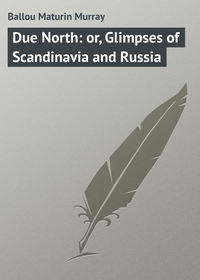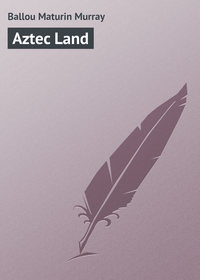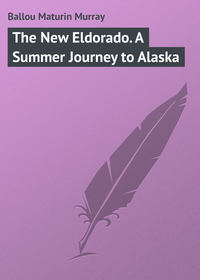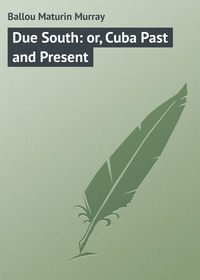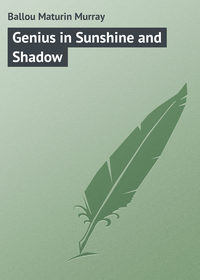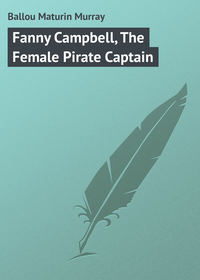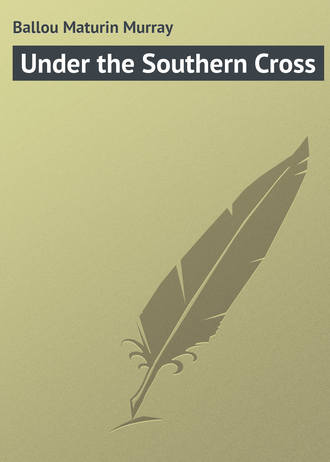 полная версия
полная версияПолная версия
Under the Southern Cross
The main thoroughfares of Sydney are not kept in a very cleanly condition, – a statement which even the residents must indorse; but the streets are full of the busy life which appertains to a great metropolis. Cabs and private vehicles dash hither and thither; heavily-laden drays grind their broad wheels over the rough pavements; pedestrians crowd the sidewalks; messenger boys, mounted upon wiry little horses, gallop on their several errands, some of them dressed in scarlet coats, signifying that they are in Government service; newspaper hawkers, boot-blacks, bearers of advertising placards, itinerant fruit-venders, Chinamen with vegetables in baskets slung on a pole across their shoulders, pass and repass one in rapid succession; omnibuses rattle furiously over the pavements, while the "going, going, gone," of the open sham auction-rooms rings upon the ear. Now and then one meets a beggar, blind or decrepit; but such are not numerous, and generally palliate their vocation as well as evade the law by offering some trifling articles for sale, such as pencils, shoestrings, or matches. In European cities, where professional beggary is so often resorted to as a regular occupation, one hardens his heart and passes these people heedlessly by; but here in Sydney he drops a trifle in the hat. Every street-corner has its bar-room, about whose doors are congregated a disreputable crowd of bloated faces and bleared eyes, among whom are seen only too many of the youth of the town, beginners in vicious habits, besides numerous idle but able-bodied representatives of the laboring classes. No part of London even is more numerously supplied with gin palaces and low tap-rooms than Sydney. The sad sight of intoxicated women staggering along the public way shocked the sensibilities, though this unfortunate exhibition was far less common than we have seen it in Liverpool and Glasgow. The demi-monde are fully represented upon the streets, – one of the sad but inevitable concomitants of a great city. Let us add, in all fairness, that this objectionable feature is certainly no more conspicuous here than in Chicago or New York, – a fact which is mentioned not to draw a comparison, but in order faithfully to depict the every-day aspect of a colonial capital.
Turning from these multiform scenes of human life, often ludicrous, but oftener painfully sad, we sought the Botanical Gardens; and after that at Calcutta, and the superb gardens of Kandy in Ceylon, this of Sydney is the next finest we remember to have seen. In round numbers these gardens embrace fifty acres of land, laid out in terraces and irregular elevations, so that many of the broad paths overlook portions of the city and harbor. The grounds extend on a gentle incline to the shores of the beautiful bay, forming a semicircle round what is known as Farm Cove, a picturesque indentation of the harbor. The several main paths are liberally ornamented with statuary representing Flora, Ceres, Commerce, Science, etc. One special charm of these delightful grounds is the fact that they are accessible by a walk of about five minutes from the centre of the city. It is not necessary to organize an excursion in order to reach them, as is the case with many similar resorts elsewhere, such as Sydenham in London, Central Park in New York, or the Bois de Boulogne, Paris. Here semi-arctic and semi-tropical plants and trees were found growing together, and all parts of the globe seemed to be liberally represented. The hardy Scotch fir and the delicate palm of the tropics jostle each other; the india-rubber tree and the laurel are close friends; the California pine and the Florida orange thrive side by side; so with the silver fern-tree of New Zealand and the guava of Cuba. China, Japan, India, Africa, Egypt, and South America, all have furnished representative trees and shrubs for these comprehensive gardens, and here they have become acclimatized. A thrifty cluster of the Indian bamboo, that king of the grasses, was seen here forty feet high, close by a specimen of the native Australian musk-tree, which attains a height of nearly twenty feet and exhales from leaf and bark a peculiarly sweet odor, though not at all like what its name would seem to indicate; it has broad, laurel-like leaves and bears a pale yellow blossom. There was pointed out to us a sheoak-tree, which it is said emits a curious wailing sound during the quietest state of the atmosphere, when there is not a breath of wind to move the branches or the leaves. This tree is almost universally found growing near the sea, and is said to have borrowed the murmur of the conch-shell. No reasonable cause is assigned for its mournful song, which has proved to be the inspiring theme of many a local poet.
Near the very centre of the gardens three Norfolk Island pines attracted particular attention because of their remarkable development. The head gardener told us that they were planted here about 1820, and they are certainly the noblest examples of their kind we have seen. The oldest one, perfect in form and foliage, is ninety-five feet high, and three feet from the ground measures fourteen feet nine inches in circumference; the other two are even taller, but measure one foot less in circumference. The density of foliage, uniformity of shape, and general perfection of these beautiful pines exceed anything of the kind to be found elsewhere.
In walking to the Garden by the way of Bridge Street, there was observed, just opposite the buildings containing the Educational Bureau, a dual tree of great size and beauty. The effect was that of one immense tree, but there were really two trunks which furnished this mountain of foliage. They were Moreton Bay Fig-trees, and were full of green fruit. This tree, the fruit of which we believe is useless, has a singular habit which recalls that of the banyan-tree; namely, that of forming many aerial roots which hang downward from the branches, though they do not grow long enough to reach the earth and produce new stock like the banyan, – which is known, by the way, as the Indian fig-tree.
Within the Botanical Gardens the flowers were as attractive and in as great variety as the trees. Fuchsias, roses, camellias in great variety, pansies of the double species, a whole army of brilliant tulips, and many other plants were in gorgeous bloom, though this was in July, which, it must be remembered, is winter in Sydney. The collection of camellias was remarkable both for the size to which they grew and for the abundance of the blossoms. Over three hundred were counted on one tree, as white as untrodden snow, all being of perfect form and freshness; there were others double, single, striped, and scarlet, all thrifty and lovely, but none of them quite equal to the myriad-decked one in white. The azaleas, double scarlet geraniums, violets, heliotropes, and daphnes were dazzling in color and confusing in their abundance. Nestling among the mounds of rock-work were succulent plants, orchids, cacti, ferns, and other pleasing forms of delicate vegetation. Flowers bloom in every month of the year in this region, out of doors, and are rarely troubled by frost.
As we came out of the Public Garden after this first visit, the last rays of the setting sun threw tremulous shadows over the foliage and the pale faces of the marble statues. The softening colors of the western sky were reflected clearly in the unruffled arm of the bay close at hand, tinging its waters with purple and golden hues. It was a scene and moment to put one at peace with all the world. The atmosphere was intoxicatingly fragrant just at this bedtime hour of the flowers, filling one here, within pistol-shot of the crowded, boisterous life of the town, with sensuous delight.
Sydney has two or three moderate-sized but very attractive arcades, – one especially worthy of note leading from George Street near the City Hall, in which are many fine shops, refreshment saloons, and cafés, with flower and fruit stores. These areas being under glass – that is, roofed over at the top of the buildings – are a favorite resort for ladies and promenaders generally. On entering these arcades one steps from deafening and confusing noise into a quiet atmosphere, with most agreeable surroundings. Not far away on George Street is the general vegetable and fruit market, where poultry and flowers are also sold. The articles are displayed with an artistic eye for color and appropriate effect. Young women are employed to sell the fruit and flowers, whose pleasant and by no means obtrusive importunity with visitors makes many purchasers. George Street is fragrant on a sunny afternoon with button-hole bouquets, purchased of these flower-girls, who evince admirable taste in the graceful and effective manner of arranging their floral gems. The display of fruit is remarkable, and the article is as cheap as it is tempting; so that those who in England or in many parts of America would not feel able to afford to indulge in oranges, apples, pears, and bananas, not forgetting the appetizing fruit of the passion-plant, here make of these a wholesome addition to their daily food-supply. Sydney is only rivalled in this respect by San Francisco, which city cannot be surpassed in the cheapness or quality of its fruit from tropical and semi-tropical regions within its own borders.
Many floral establishments solely devoted to the sale of plants and cut-flowers were observed in different sections of the city with very beautiful displays in their large plate-glass windows. It is only a liberal population of refined taste which will support these attractive establishments; their manifest thrift tells its own story.
If in these notes we speak most frequently of the common classes, depicting scenes illustrative of humble and every-day life among the masses, it is because such are the most representative; but the reader may be sure that there is another class happily existing in Sydney, and in all of these Pacific colonies, where the author met with and shared the hospitality of many cultured people, who exhibited a degree of refinement unsurpassed in the best of our own home circles. Some writers choose to dilate upon their intercourse with such people, giving the names of officials and the initials of private individuals from whom they received entertainment; but it seems to us better to avoid such personal mention, in which the reader can feel very little interest.
The University of Sydney, admirably situated about a mile from the business portion of the city, not far from the Alfred Hospital, is the first that was founded in the Southern Hemisphere. In its immediate neighborhood are the affiliated colleges of St. Paul, St. Andrew, and St. John, belonging respectively to the Church of England, the Presbyterian denomination, and the Roman Catholics. Religious instruction is given at these colleges, but not in the University. This edifice is of Gothic architecture, built of freestone, and is situated in spacious elevated grounds overlooking Victoria Park and the city, being enclosed by a high iron fence. Within this enclosure, which is several acres in extent, the land is terraced and ornamented with choice trees and flowers. The façade of the main building is over four hundred feet in length. On one side is a fine large stone building just finished, which is designed for a Medical School; and on the other is a spacious structure appropriated to the purpose of a museum, where we found some thousands of classified objects of special interest as antiquities. The object of the University is to afford a liberal education to all orders and denominations without distinction. Graduates rank in the same order as those of similar British home institutions. This University was originally founded by Government, but from time to time it has been the recipient of rich endowments from private sources, until it has become nearly self-supporting. The great hall of this building deserves particular mention. It is a remarkable apartment finished elaborately in the Elizabethan style, and is lighted by ten large stained-glass windows. In these were observed representations of the sovereigns of England, from William the Conqueror to Queen Victoria. Several of these windows are the gifts of wealthy patrons. The room is about a hundred and fifty feet in length and fifty wide, with a ceiling reaching to the roof, being at least seventy feet in height, finished in Gothic style and forming a marvel of carpentry, carving and painting. The citizens of Sydney may well be proud of this admirably appointed University.
The Art Gallery is a low one-story iron building in the grounds of the park known as the Domain, and it well repaid a visit of a few hours, though it is at present only the nucleus of a future collection. It contains some excellent modern pictures by popular artists, English and French. One fine example by Louis Buvelot, an Australian artist, is full of merit. There are many excellent models of classic sculpture, including the group of the Laocoön. Some choice water-colors interested us, and there were some meritorious pieces of sculpture by native artists. One or two unselfish and devoted friends of art in Sydney have given the most of their time and much of their pecuniary means for years to promoting the interests of this collection, which under their fostering care has already reached a high intrinsic value, and is full of promise of future permanence and still greater excellence.
On the way back to our hotel from visiting the Art Gallery we stopped at the Free Public Library, which contains over one hundred thousand volumes arranged after a most admirable system. Not only do the immediate residents of the city and its environs enjoy the advantages of this collection, but the books are sent all over New South Wales, upon application from local authorities, in boxes containing one hundred volumes each, free of transportation. To secure this privilege in any instance, it is only necessary for the town authorities to sign a bond, making themselves responsible for the return of the books within a given period, or agreeing to pay for any that are lost. This system of distribution, we were told, worked admirably, involving no loss and no more wear and tear than any other consistent use of the books, while the benefits of the library are thus extended to half a million of people.
Another circulating library, known as Maddock's Select Library, was found in George Street, after the style of Mudie's in London, or Loring's in Boston, the object of which was to supply its patrons with the best books and serial publications as soon as published. Besides the periodical literature of the day, this establishment contains thousands of standard books, which are constantly lent for a moderate sum to the reading public. This library, we were told, has been established for twenty years, and has really become a city institution. It is only upon visiting places which do not possess such convenient literary resorts that one can properly estimate their public value and importance.
Walking about the wharves in the early morning we one day saw and awaited the mooring of the incoming boat from Parametta. It was crowded with merchants' clerks, shop-keepers, and business people generally who are employed in the city during the day, but who return to their suburban homes to sleep. Among these were women from the shores of the river and harbor, with baskets of cut-flowers for the Sydney market. They were all neatly dressed, bright-looking girls and women, as rosy as their lovely wares. Some of them had two long light frames of wire which they carried in each hand, and in the openings of which were double rows of flowers, enabling each girl to carry a score and more of bouquets. These were glowing with morning freshness imparted by "some sweet mystery of the dew," and were composed of camellias in three or four colors, lilies of the valley, blue violets, and tea-roses, with sheltering borders of maiden's-hair fern and other varieties of green. All these were of out-door growth. Truly, flowers are appreciated, cultivated, and loved all over the world; even here in Eldorado they delight the eye with their beauty and the senses with their fragrance.
A brief day devoted to a trip from Sydney to the town of Parametta will well repay the visitor; and to vary the scene one should go thither by steamboat and return by the Sydney and Bathurst Railroad. This excursion gives one a better idea of the harbor in detail than can be acquired in any other manner. The comfortable little passenger-boat skirts the shore and winds among the small islands, stopping at many of them to land or to take up passengers. These islands are clotted with villas and cottages, each having a two-story veranda, generally decked with vines, and all overlooking the bay. The boat passes under a picturesque iron bridge painted white, which crosses an arm of the sea. Skilled oarsmen are constantly pulling up and down the Parametta River in their long, pointed, egg-shell boats, for here is the famous boat-race course. Verdant and well-wooded lawns of exquisite green sweep grandly down to the water's edge. Orange and lemon trees, with here and there a group of bananas and other tropical plants, bend gracefully over the tide. Now and again the Australian ivy beautifies the shore, creeping over the quaint little cottages and bursting out at times in clouds of yellow blossoms on rocky promontories and gently swelling knolls. One recognizes also the scarlet nasturtium and beds of soft blue violets intermingling with fragrant jonquils. The lily of the valley, forgetting that it is winter here, opens its bell-like blossom of snowy-white and fills the whole air with dainty sweetness. The green and striped aloe grows wild in clusters affording variety and beauty of effect to all around. There were here and there clusters also of the yellow-leaved wattle, producing by its foliage almost the exact effect of blossoms; and as the river is ascended, an abundance of the water-loving mangrove is seen bordering the banks, like willows in New England. And if one turns for a moment from the enchantment near at hand, far away over the plains and undulating country, mingling with the very clouds, are seen the Blue Mountains. All far-away mountains present an aspect of blue, but those of New South Wales are indeed cerulean.
A quiet aspect of stupid respectability, if we may be permitted the term, environed the town of Parametta. It is a dull place, and fully merits its expressive nickname of Sleepy Hollow. One is half inclined to look for a coating of blue mould over the streets and houses. While driving in the neighborhood, where everything seemed so purely English, one felt the sight of the many orange-trees in full bearing, or the flitting about of small paroquets, to be a sort of incongruity. The early colonists, as we were told, tried to raise wheat hereabout, but the soil was ill adapted to that cereal, though for raising oranges and semi-tropical fruits Parametta has since become quite famous.
The town is just fifteen miles from Sydney, and has in its environs some beautiful drives. Rocky Hall, the residence of a hospitable and wealthy citizen, not far from the town of Parametta, contains in its spacious grounds an orchard with a marvellous variety of growing fruits. The proprietor, Mr. James Pye, is good authority on all subjects relating to horticulture. The salubrious character of the climate has enabled this gentleman to produce in abundance thriving specimens of nearly every known fruit either tropical or hardy, added to which he has a large and choice variety of flowers.
We are reminded in this connection of one of the pleasantest drives in Sydney, not to be forgotten by the visiting stranger, – that along the shores of Port Jackson. Here, within a few minutes' walk of the heart of a populous city, we have rippling waters, waving foliage, frequent gardens, vine-clad cottages, a yellow pebbly shore, and a bay full of maritime beauties, – all combining to form a lovely panorama full of local color and of infinite variety.
But even the beautiful aspect of Sydney harbor has its drawbacks. With a single oarsman we crossed the bay from Port Jackson shore, and as we glided quietly over the water and looked down into the depths alongside, we saw more than one hideous man-eating shark of the dreaded white species, stealthily in search of human prey. Though they feed on other fish, the white sharks seem to prefer human flesh to all other, and will remain patiently for days at a time in the same spot, watching for a chance to satisfy this terrible appetite. Sad accidents from this source are not infrequent, two young lads from an overturned boat having been seized and eaten by these voracious creatures just one week previous to our arrival in Sydney. The instance here referred to was particularly afflicting as we heard it described. The father of one of the boys was the horrified witness of the scene, without being able to render his son the least assistance.
The sharks which frequent the coast of Norway, the catching of which forms a regular industry there, are what are termed the mackerel shark, because they feed mostly upon that fish. The size of this kind averages from six to eight feet in length; but those which frequent the coast of Australia will measure from ten to twelve feet, and have enormous mouths furnished with four or five rows of long sharp teeth. They are well called the tigers of the sea.
CHAPTER V
A Zigzag Railway. – Wonderful Series of Caves. – Immense Sheep-Runs. – Sheep-Shearing. – Central Australia. – City Characteristics. – Fine Architectural Development. – Steam Tramways. – Labor Unions. – Colonial Federation. – The Tariff. – Loyalty to England. – Spirit of Local Rivalry. – The St. Giles of Sydney. – City Clubs. – The Laughing Jackass. – Public Parks. – Gold Mines.
There is one special excursion which should not be neglected by travellers to Sydney; namely, a visit to what are called the Fish River Caves at Tarana. No person would neglect them who could anticipate the novel experience to be enjoyed by such a visit, which need occupy but four days' time. We had not even heard of these singular wonders of Nature's handiwork before coming hither. The short journey to the caves takes one through a delightful though wild and mountainous region, replete with grand natural scenery. The route leads through the Emu Plains and over the Blue Mountains by the Zigzag Railroad, from whose various elevations lovely far-reaching views are enjoyed of the district left behind and the gleaming Nepean River winding gracefully through it. This range of mountains reaches a height of three thousand four hundred feet, intersected by precipitous ravines fifteen hundred feet in depth, and by gulches scarcely excelled in our own Rocky Mountains. One is reminded here most forcibly of the precipitous zigzag road at Darjeeling, in India, which ascends toward the Himalayan range, and which is nearly as remarkable as this example of Australian engineering. We were told that this Zigzag Railroad of five miles more or less in length cost three million dollars, and saw no reason to doubt it. In working out some of the levels from the face of the precipitous and rocky sides of the mountain, laborers were suspended by ropes from holding-ground far above their heads, and very many of the cuttings were accomplished under equally trying circumstances. As a piece of daring and successful engineering there is nothing to equal it in the Southern Hemisphere.
The subterranean temples and halls of limestone which constitute these remarkable Fish River Caves are of vast extent, filled with many intricate windings, galleries, and irregular passages, in which one would inevitably be lost without an experienced and faithful guide. The many apartments are known by special names, and there are several singularly perfect archways whose exact proportions no architect could improve. These caves present some of the most beautiful stalactites we have ever seen, and in many prominent features they are considered to be unique. Whole days of examination would not exhaust their variety. One of the caves is of cathedral dimensions, having a height of five hundred feet and a length and breadth according well with its altitude. Another of the apartments is appropriately designated as the Menagerie, on account of the peculiar shapes produced by the crystal-like formations, from which the imagination can easily create various animals.
When lighted, these subterranean palaces form a gorgeous spectacle. One peculiar division is called the Bell Tower, being a small chamber in which are five or six stalactites hanging near together, and which when struck give out rich metallic tones similar to a chime of bells. For extent, variety, and beauty combined, these buried halls and chambers have no equal so far as our experience goes, though they recall the grotto of Adelsberg, near Trieste, which exhibits some similar features, and also the subterranean caverns in the environs of Matanzas, Cuba. In these Fish River Caves the fantastic shapes assumed by the limestone formations are infinite in variety, as well as weird and singular in their groupings. But perhaps they excel most particularly in their beautiful coloring, in many instances presenting great brilliancy of lustre, which causes the individual stalactites to seem like ponderous opals.




